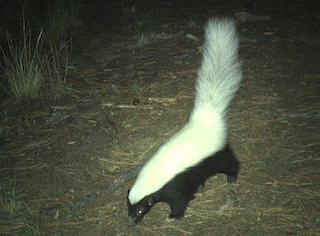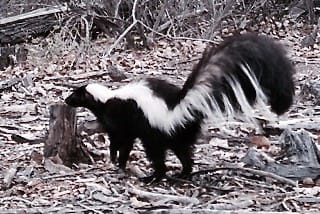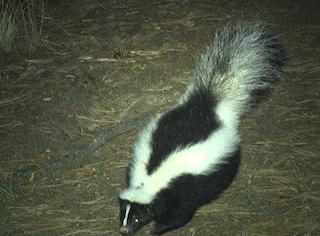This guide initially displays all common mammals. Use the selectors below to view mammals of a particular shape, include rare mammals, or search for them by name.
Mammals are defined as warm-blooded vertebrates with hair or fur and sweat glands — in the females mammary glands, modified sweat glands, produce milk to nourish the young. Most mammals develop a placenta which enables the feeding of the fetus during gestation and give birth to live young. In addition, although most mammals walk on land, many have specific adaptations that allow them to swim, fly, leap between tree branches or even dig extensive tunnels. Many wild mammals are used for both food and fur. while other have been domesticated for their agricultural and scientific importance.
New Mexico ranks high for mammalian diversity in the states in the US and the Pajarito Plateau is home to many of these species. This guide describes all of the larger wildlife found in the area as well as the more common smaller animals with the most abundant being rodents. Local species range from carnivores like the mountain lion and bobcat to ruminants like elk and deer to to several varieties of bats.
Mammal References
Biota Information System of New Mexico
Bogen et al. 1998 Continued Studies of Bat Species of Concern in the Jemez Mountains, New Mexico [PDF]
eNature
Frey et al. 2006 Checklist of New Mexico Mammals [PDF]
New Mexico Tech Mammalian Field Guide
Smithsonian National Museum of Natural History North American Mammals
Threatened, Endangered and Sensitive Species Profile – Los Alamos Laboratory Lands [PDF]
Tyrell and Brack 1992 Survey for Bats in the Los Alamos National Environmental Research Park
Subject Area Experts (all guides)
Steve Cary (butterflies)
Beth Cortright (insects)
Terry Foxx (invasive plants)
Leslie Hansen (mammals)
Richard Hansen (fish, mammals)
Dorothy Hoard (butterflies, trees)
Chick Keller (flowers, herbarium)
Shari Kelley (geology)
Kirt Kempter (geology)
Garth Tietjen (reptiles)
David Yeamans (birds)
Web Development and Content Management
Pat Bacha
Jennifer Macke
Graham Mark
Akkana Peck
Contact
Please contact us for local nature questions and sightings. We welcome comments, corrections, and additions to our guides.
For more information about local nature, please visit our Nature Blog or subscribe to PEEC This Week.
Make Selection
 Photo: Hari Viswanathan |  American Hog-nosed Skunk, Western Hog-nosed Skunk(Conepatus leuconotus)Family: Mephitidae (Skunks) Size: 20 - 31 in (51 - 79 cm) Status: native; rare Habitat: desert, woodlands, grassy plains, forests, brushlands Typical location: Los Alamos The Hog-nosed Skunk is distinguished from the more common Striped Skunk by having an all-white back, a less-plumed tail, and a longer snout. Skunks eat various plant materials as well as insects, and the Hog-nosed Skunk is more insectivorous than other skunks. Like all skunks, it has the ability to spray a foul-smelling fluid from two glands near the base of its tail. Tracks Info Photos Distribution |
 Photo: J. N. Stuart  Photo: Hari Viswanathan |  Striped Skunk(Mephitis mephitis)Family: Mephitidae (Skunks) Size: 20 - 31 in (51 - 79 cm) Status: native; common Habitat: desert, woodlands, grassy plains, cities and town, forests, brushlands Typical location: Los Alamos The Striped Skunk is nocturnal and eats various plant materials as well as insects, worms, rodents, amphibians and reptiles, eggs and even garbage. Like all skunks, it has the ability to spray a foul-smelling fluid from two glands near the base of its tail. It typically raises its tail and stomps its front feet before spraying. It uses this ability cautiously as it only carries enough fluid for a few uses and then must wait a week or so for the supply to be replenished. The Striped Skunk has few natural predators except birds of prey. It is currently the chief carrier of rabies in the US. Tracks Info Photos Distribution Featured |
